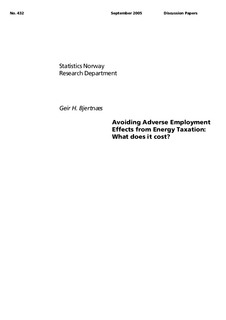Avoiding adverse employment effects from energy taxation: What does it cost?
Working paper

View/
Date
2005Metadata
Show full item recordCollections
- Discussion Papers [1003]
Abstract
Abstract:
Welfare analysis of energy taxes typically shows that systems with uniform rates perform better than
differentiated systems. However, most western countries include some exemptions for their energyintensive
export industry, and hence, avoid this potential welfare gain. Böhringer and Rutherford
(1997) find that compared to a differentiated system, uniform taxation in combination with a wage
subsidy preserve jobs in these industries at a fraction of the potential welfare gain in the German
economy. This result holds in this Norwegian study where a more broad based subsidy scheme,
represented by production dependent subsidies, is used to protect jobs in the Norwegian energyintensive
industry. However, the welfare cost per job preserved by this subsidy scheme amounts to
about 60 percent of the wage cost per job, suggesting that these jobs are expensive to preserve.
Keywords: Energy taxes, Political feasibility, Competitiveness, CGE models